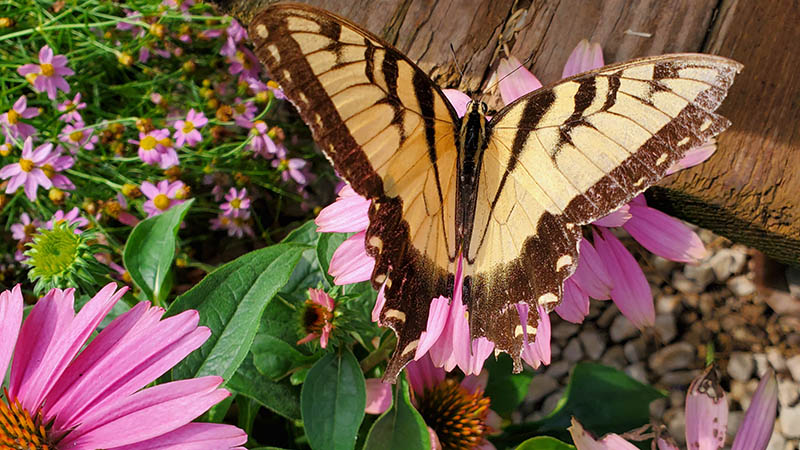Pollinators need you. You need pollinators.
Birds, bats, bees, butterflies, beetles, and other small mammals that pollinate plants are responsible for bringing us one out of every three bites of food. They also sustain our ecosystems and produce our natural resources by helping plants reproduce.
Pollinating animals travel from plant to plant carrying pollen on their bodies in a vital interaction that allows the transfer of genetic material critical to the reproductive system of most flowering plants—the very plants that:
- bring us countless fruits, vegetables, and nuts,
- ½ of the world’s oils, fibers and raw materials;
- prevent soil erosion,
- and increase carbon sequestration
This nearly invisible ecosystem service is a precious resource that requires attention and support—and in disturbing evidence found around the globe, is increasingly in jeopardy.
What is pollination?
When a pollen grain moves from the anther (male part) of a flower to the stigma (female part), pollination happens. This is the first step in a process that produces seeds, fruits, and the next generation of plants. This can happen through self-pollination, wind and water pollination, or through the work of vectors that move pollen within the flower and from bloom to bloom.
Who are the pollinators? Butterflies…

Birds, bats, butterflies, moths, flies, beetles, wasps, small mammals, and most importantly, bees are pollinators. They visit flowers to drink nectar or feed off of pollen and transport pollen grains as they move from spot to spot.
Why are pollinators important?
Somewhere between 75% and 95% of all flowering plants on the earth need help with pollination—they need pollinators. Butterflies and other pollinators provide pollination services to over 180,000 different plant species and more than 1200 crops. That means that one out of every three bites of food you eat is there because of pollinators. If we want to talk dollars and cents, pollinators add 217 billion dollars to the global economy, and honey bees alone are responsible for between 1.2 and 5.4 billion dollars in agricultural productivity in the United States. In addition to the food that we eat, pollinators support healthy ecosystems that clean the air, stabilize soils, protect from severe weather, and support other wildlife.
WHAT DO WE KNOW ABOUT BUTTERFLIES & POLLINATORS STATUS?
Pollinator populations are changing. Many bee, butterfly, and other pollinator populations are in decline and this decline is attributed most severely to a loss in feeding and nesting habitats. Pollution, the misuse of chemicals, disease, and changes in climatic patterns are all contributing to shrinking and shifting pollinator populations. In some cases there isn’t enough data to gauge a response, and this is even more worrisome.
How can you help?
Pollinators need help and we know how to help them! Scientists and research partners that have been studying pollinators for over three decades have been able to show that conservation techniques work. If everyone—home owners, local governments, national governments, and private industry—made the effort, we could change the future for pollinators and secure our own.
HABITAT AREA COUNTS
Adding natural habitat areas into farm systems would work. Farms that are closer to natural habitats produce more crop yield because they attract more pollinators. Adding habitats to farms systems can work too. Farms that have turned a potion of their fields into green space have gained back more overall yield.
Home owners can help too! Home gardens can and do attract pollinators, and in many cases suburbs and cities have been shown to have more diverse pollinator communities than nearby wildlands. Pollinators don’t seem to be phased by city life, as long as there are plots and patches of flowers they will be visited by hungry bees. Pollinator gardening near community gardens also increases urban agricultural yields. If you build it, they will come and help you get bigger and better crops too!
PLANT THE RIGHT PLANTS
There are planting guides that helps you select the right plant for the right spot. You can even plant certain plants to attract certain pollinators such as butterflies, bees, and hummingbirds. Plant the right plants on highway rights of ways, farms, schools, home gardens, corporate landscapes, and on public spaces. It really will matter for all of us. See our nursery & garden center pages for products that can help you!
Information sourced from: https://www.pollinator.org/pollinators
